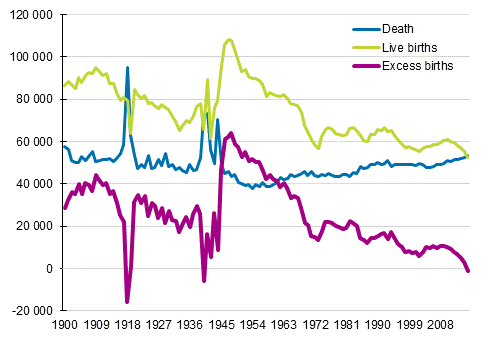Published: 25 January 2017
Number of births smaller than the number of deaths in 2016
According to Statistics Finland's preliminary data, the number of births was smaller than that of deaths for the first time during 1900–2016, except for the years 1918 and 1940. The number of births has now decreased for the sixth year in succession. Since there was no natural population increase, the population grew only as a result of international net migration.
Deaths, live births and excess of births in Finland 1900–2016*

*) Preliminary figure in 2016
The preliminary statistics show, our country's population grew in 2016 by 15 285 persons and amounted to 5 502 593 at the end of the year. Population increase went down by 270 persons from one year earlier.
According to the preliminary statistics, 52,645 children were born in 2016, which is the lowest figure during our independence. The number of births was 2,827 lower than in the previous year. The number of deaths was 53,629, which is 1,137 higher than one year earlier. The number of births was 984 smaller than that of deaths. The number of births exceeded deaths only in Uusimaa, North Ostrobothnia, Pirkanmaa, Ostrobothnia and Central Ostrobothnia.
By the end of December, 32,276 persons moved to Finland from abroad and 16,007 persons abroad from Finland. In all, 7,588 of the immigrants and 11,221 of the emigrants were Finnish citizens. The number of immigrants was 3,530 higher and the number of emigrants 298 lower than during the previous year. The net migration gain was 16,269 persons and 3,838 higher than in 2015.
The number of inter-municipal migrations totalled 278,927 from the beginning of the year to the end of December. Compared with the previous year, the decrease was 1,557 migrations according to the municipal division of 2016.
According to preliminary data by region, the population grew in January to December 2016 in Uusimaa, Pirkanmaa, Varsinais-Suomi, North Ostrobothnia, Central Finland and Åland.
The population grew in absolute numbers most in Uusimaa, where it went up by 18,208 persons. The next largest increase in population was seen in Pirkanmaa, 3,165 persons. Relative to the population, population increase was highest in Uusimaa, 11.2 per mil and in Åland, 8.1 per mil. Relative population growth was third largest in Pirkanmaa, 6.2 per mil. Population loss was highest in absolute numbers in the region of Satakunta that lost 1,412 persons of its population. The population of Etelä-Savo decreased by 1,377 persons, which was the second biggest population loss. In relative terms, the population loss was biggest in Etelä-Savo, 9.2 per mil.
Most migration gain from intramunicipal and international net migration or total net migration was recorded for Uusimaa, 13,025 persons and Pirkanmaa, 2,956 persons. Most migration gain in relative terms from total net migration was attained by Åland, 8.2 per mil and by Uusimaa, 8.0 per mil.
In absolute numbers, migration loss from total net migration was biggest in the region of Satakunta, 516 persons. In the region of Ostrobothnia the loss was 445 persons. In relative terms, the biggest migration loss from total net migration was found in Central Ostrobothnia, 2.7 per mil of the population.
During January to December 2016, migration between regions numbered 131,607. The highest gain from migration between regions was seen in Uusimaa, Pirkanmaa, Varsinais-Suomi, Åland, Päijät-Häme and Central Finland. In absolute numbers, the highest gain from migration between regions was received by Uusimaa, 6,486 persons. The relative migration gain was highest in Uusimaa, 4.0 per mil, and in Pirkanmaa, 3.6 per mil of the population.
In absolute numbers, migration loss in migration between regions was biggest in the region of North Ostrobothnia, 1,377 persons. Migration loss from migration between regions was biggest in relative terms in the region of Kainuu, 6.2 per mil of the population.
Source: Preliminary population statistics, Statistics Finland
Inquiries: Miina Keski-Petäjä 029 551 3240, Matti Saari 029 551 3401, info@stat.fi
Director in charge: Jari Tarkoma
Publication in pdf-format (296.9 kB)
- Tables
-
Tables in databases
Pick the data you need into tables, view the data as graphs, or download the data for your use.
Appendix tables
- Appendix table 1. Preliminary data on vital statistics by month of occurrence 2016 (25.1.2017)
- Appendix table 2. Vital statistics, final data 2010 - 2015 and preliminary data 2016 (25.1.2017)
- Appendix table 3. Comparison between preliminary vital statistics in 2016 and 2015 (25.1.2017)
- Appendix table 4. Preliminary vital statistics by region 2016 and change compared to 2015 final data, quarters 1 - 4 (25.1.2017)
- Appendix table 5. Preliminary data by region on immigrants and emigrants according to country of departure/destination 2016, quarters 1 - 4 (25.1.2017)
- Figures
-
- Appendix figure 1. Live births by quarter 1994 - 2015 and preliminary data 2016 (25.1.2017)
- Appendix figure 2. Deaths by quarter 1994 - 2015 and preliminary data 2016 (25.1.2017)
- Appendix figure 3. Intermunicipal migration by quarter 1994 - 2015 and preliminary data 2016 (25.1.2017)
- Appendix figure 4. Immigration by quarter 1994 - 2015 and preliminary data 2016 (25.1.2017)
- Appendix figure 5. Emigration by quarter 1994 - 2015 and preliminary data 2016 (25.1.2017)
Updated 25.1.2017
Official Statistics of Finland (OSF):
Preliminary population statistics [e-publication].
ISSN=2243-3627. December 2016. Helsinki: Statistics Finland [referred: 17.4.2025].
Access method: http://stat.fi/til/vamuu/2016/12/vamuu_2016_12_2017-01-25_tie_001_en.html

